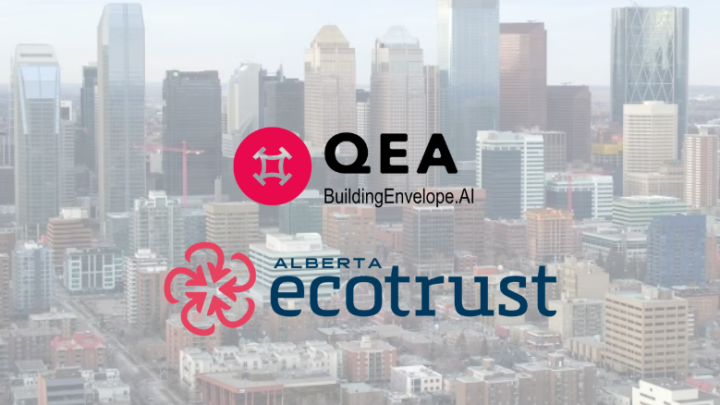QEA Tech completed detailed building envelope energy audits for a world-renowned hospital based in the US. The Hospital has numerous properties across a large dense city, provides a wide range of healthcare services, and includes a Level I trauma center. QEA Tech completed audits for 12 of the Hospital’s buildings, spanning multiple city blocks.
The Hospital enlisted QEA Tech’s services as it lacked the data it needed to integrate the building envelope into its decarbonization plan. The Hospital was motivated to enact decarbonization measures due to the old age of its buildings and high energy bills. Particularly, the Hospital suspected poor performance of its windows and sought data on their actual U-values. QEA Tech was selected as we provide detailed and actionable insights, which was optimal for the large size and number of the Hospital campus’s buildings.
Operations
QEA Tech’s drone operations spanned approximately 860,000 square feet with data being collected within 7 days. QEA Tech’s operations had to be efficient and non-intrusive to not disturb 24/7 hospital operations. The data collected was processed and analyzed by our AI-powered proprietary software, calculating the energy loss, greenhouse gas emissions, potential energy and greenhouse gas emissions savings, and actual effective U-values/ R-values for each building envelope element. Additionally, QEA Tech identified over 4800 issues related to the Hospital’s building envelopes, such as heat loss through connections of building envelope elements, thermal bridging, and heat loss through the window frame.
Key Findings
Through our audit, QEA Tech found that:
- 62% of annual building envelope energy loss in megawatt-hours (MWh) can be avoided by upgrading the envelopes to building code.
- >$850,000 in annual energy expenditures can be saved by upgrading building envelopes to building code.
- 1451 tons of carbon dioxide equivalent (tCO2e) are avoidable annually by upgrading building envelopes to building code.
- The average payback period to recoup costs of all the retrofits recommended in our audit is 7 years.
Total % of Energy Loss (MWh) from Each Building Envelope Element

Graph Insights
Walls were a primary source of heat loss for most of the buildings assessed. Reasons for energy loss include:
Heat loss due to connections of building envelope elements: Due to the old age of the Hospital campus’s buildings, this is likely caused by connections of building envelope elements not being continuously insulated or thermal layers decaying over time. Degradation of materials over time can lead to cracks or openings between building envelope elements, further increasing energy loss.
Inconsistent, decay of, or no insulation: Age and moisture accumulation throughout the building envelope has likely caused the insulation of the Hospital’s buildings to deteriorate, leading to reduced R-values and effectiveness.
Thermal bridging: As buildings age, settling and material degradation can lead to cracks or openings at junctions, amplifying thermal bridging issues. Thermal bridges occur when a more conductive material creates a direct pathway for heat transfer across less conductive areas of the building envelope, increasing energy loss.
Top Issues
Poorly Performing Windows
The average U-values calculated for the majority of the Hospital’s windows were performing significantly below building code, resulting in over $500,000 of annual heating and cooling loss attributed to windows. Some windows in the Hospital displayed heat loss through insulated glass units (IGUs), losing insulating gas fill due to failing seals.
QEA Tech recommended that the Hospital apply window inserts for the poorly performing windows identified by QEA Tech. These inserts are customized glass panes that can be placed on the inside or outside of the existing window. This creates a new thermal boundary that improves U-values while minimizing disruptions to hospital operations and patient care. Further, these inserts are more cost effective than traditional window replacement and take a fraction of the time to implement. The total potential energy savings of implementing this retrofit for the Hospital amounts to 7527 MWh. It will take approximately 10 years to recoup the costs of performing this retrofit.
Moisture Accumulation within Roofing Membrane and Roofing Tiles
Moisture accumulation on the Hospital’s roofs was likely caused by poorly ventilated roofing systems resulting in condensation beneath the roofing membrane and stagnant water from rainfall that was not properly drained. This is a significant issue as water trapped beneath the roofing membrane creates an environment for mold growth, rot, and deterioration of roofing material, negatively affecting the health of the Hospital’s occupants.
To address this issue, it is recommended that the drainage systems on the roof are regularly inspected and cleaned. In addition, the damaged areas of the roof should be remediated by applying an insulation layer and a durable roof membrane (e.g. bitumen layer). Lastly, the roof should be sealed against potential leaks. This approach is designed to provide the Hospital with a roof expected to last an additional 15-20 years, addressing existing leaks and other roofing issues. Moreover, this method is more cost-effective than a full roof replacement and better meets the needs of the Hospital by allowing it to remain fully operational during the renovation.


